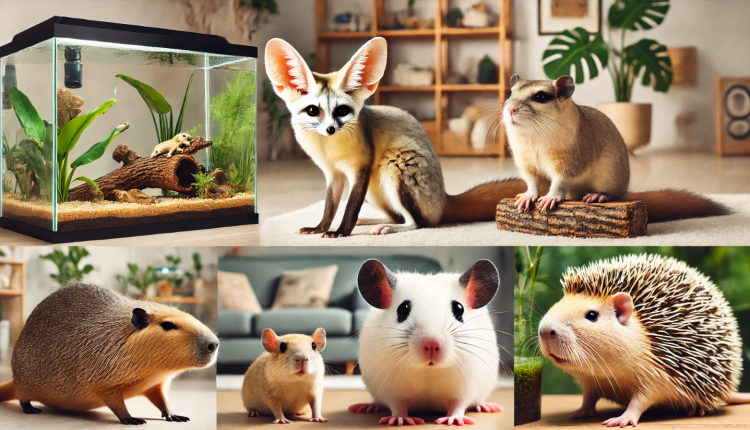Exotic Pets: A Journey into Unconventional Companionship
The allure of exotic pets has captivated animal enthusiasts worldwide. Beyond the familiar realm of cats and dogs lies a diverse array of creatures that, despite their wild origins, have found their way into domestic settings. This exploration delves into various exotic species that individuals have chosen as companions, highlighting their unique characteristics, care requirements, and the ethical considerations involved.
Fennec Foxes: Desert Dwellers in Domestic Spaces
Overview
Native to the Sahara Desert, fennec foxes (Vulpes zerda) are renowned for their diminutive size and distinctive large ears, which serve to dissipate heat. Their endearing appearance and playful demeanor have made them a sought-after exotic pet.
Care Considerations
Fennec foxes are nocturnal and possess high energy levels, necessitating ample space for exercise. Their diet in captivity should mimic their natural intake, including proteins like insects and rodents, supplemented with fruits and vegetables. Prospective owners must ensure a secure environment, as these foxes are adept escape artists.
Ethical and Legal Implications
Ownership of fennec foxes is regulated in many regions due to their wild status. Potential owners should research local laws and consider the ethical ramifications of domesticating a wild species.
Hedgehogs: Quilled Companions
Overview
African pygmy hedgehogs (Atelerix albiventris) have gained popularity as pets due to their manageable size and unique appearance. These nocturnal insectivores are characterized by their spiny coats and curious personalities.
Care Considerations
Hedgehogs require a warm environment, ideally between 72-80°F (22-27°C), to maintain their health. Their diet should consist of high-quality cat food supplemented with insects, fruits, and vegetables. Regular handling from a young age can help them become more comfortable with human interaction.
Ethical and Legal Implications
While hedgehogs are legal pets in many areas, some regions have restrictions due to concerns about invasive species and disease transmission. Prospective owners should verify local regulations before acquiring a hedgehog.
Sugar Gliders: Gliding Marsupials
Overview
Sugar gliders (Petaurus breviceps) are small, nocturnal marsupials native to Australia and New Guinea. Their ability to glide between trees and their social nature have endeared them to exotic pet enthusiasts.
Care Considerations
Sugar gliders thrive in social settings and should ideally be kept in pairs or groups to prevent loneliness. Their diet is complex, requiring a balance of fruits, vegetables, proteins, and specialized supplements to mimic their natural intake. A tall, spacious cage with opportunities for climbing and gliding is essential for their well-being.
Ethical and Legal Implications
The social and dietary needs of sugar gliders pose challenges for domestic care. Additionally, their ownership is restricted in certain regions due to ecological concerns. Prospective owners must consider their ability to meet these needs and adhere to local laws.
Capybaras: Gentle Giants of the Rodent World
Overview
As the world’s largest rodents, capybaras (Hydrochoerus hydrochaeris) are semi-aquatic mammals native to South America. Their docile temperament and social nature have led some to keep them as unconventional pets.
Care Considerations
Capybaras require access to ample outdoor space with a water source for swimming, reflecting their natural habitat. They are social animals and fare better with companionship, either from their own species or other compatible animals. A diet rich in grasses and aquatic vegetation is essential for their digestive health.
Ethical and Legal Implications
Due to their size and environmental needs, capybaras are challenging to accommodate in typical domestic settings. Legal restrictions on their ownership exist in various regions, necessitating thorough research and consideration before acquisition.
Axolotls: The Perpetual Juveniles
Overview
Axolotls (Ambystoma mexicanum) are aquatic salamanders native to Mexico, known for retaining their larval features throughout adulthood—a phenomenon called neoteny. Their unique appearance and regenerative abilities have fascinated pet owners and scientists alike.
Care Considerations
Axolotls require a cool, aquatic environment with minimal light exposure. A tank with a capacity of at least 10 gallons, equipped with a gentle filtration system, is recommended. Their diet consists of protein-rich foods such as worms, small fish, and specialized pellets.
Ethical and Legal Implications
While axolotls are legal to own in many areas, they are critically endangered in the wild. Responsible ownership includes sourcing from reputable breeders and understanding the commitment to their specialized care requirements.
Conclusion
The fascination with exotic pets introduces a spectrum of unique and captivating creatures into human lives. However, the decision to keep such animals demands careful consideration of their specific care needs, the owner’s ability to meet these requirements, and the broader ethical and legal implications. Prospective exotic pet owners must conduct thorough research, consult with experts, and reflect on the responsibilities inherent in bringing a piece of the wild into their homes.

